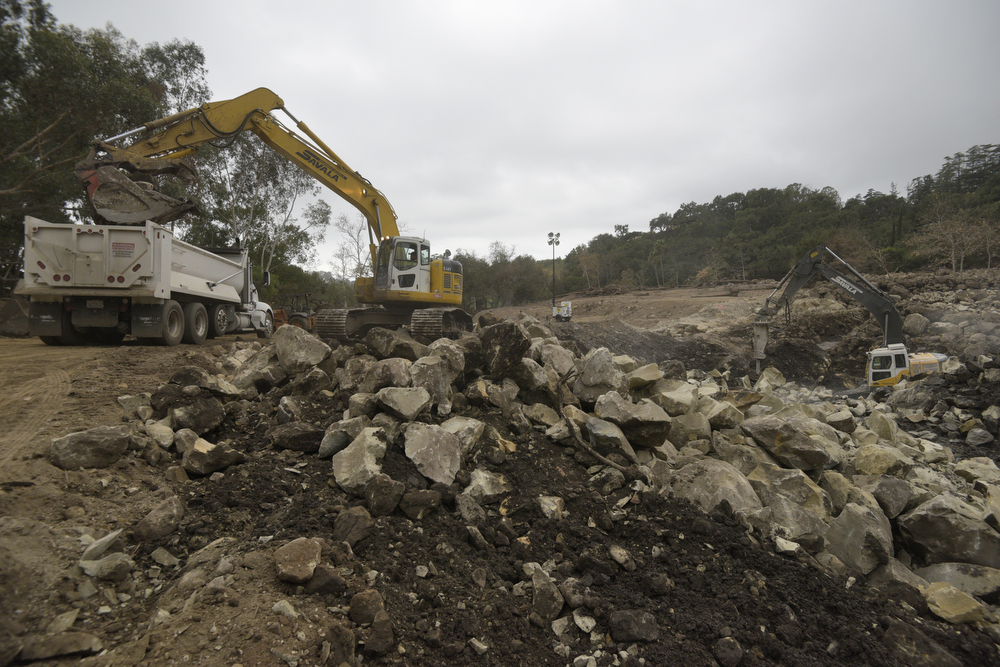Local Recovery and Assistance Center Is One-Stop Shop for Help
Thomas Fire, Mudslide Victims Offered a Range of Services

As the days unfold after the Thomas Fire and Montecito mudslides shook the Santa Barbara community to its core, recovery and relief organizations have banded together to assist those both directly and indirectly affected in one streamlined process.
The Calvary Chapel of Santa Barbara is now home to the LAC, or the Local Recovery and Assistance Center. In the place of pews are dozens of tables occupied by volunteers and spokespeople for federal, state, and local assistance programs, such as the Foodbank of Santa Barbara County, the County Public Health Department, the Small Business Administration, SoCalGas, Unity Shoppe, and The Salvation Army.
“It’s a one-stop shop for families that have been affected by the Thomas Fire and the January storm,” said Katie Torres, one of the lead managers running the center. “They can come and get all the resources and support they need to get back on their feet.”
Within just eight days of the LAC’s opening, it had seen about 1,000 residents and 180 return visitors. Their needs ranged from the expected — such as insurance assistance, employment assistance, business recovery, and utilities help — to more obscure needs such as animal assistance and record replacement. According to Beth Johnson, chair of the American Red Cross Pacific Coast chapter, approximately 7,400 meals and snacks and more than 3,500 sleep “comfort” kits have been handed out.
Several organizations within the center are also geared to assist people with needs that may become more and more apparent once the basic necessities of food, water, and shelter are met. Those who have been injured, who have lost their homes or loved ones, or who are suffering from mental-health issues also have a number of services available to them. Johnson, who is working to ensure people have access to crisis counselors and spiritual workers, said the Red Cross has had about 1,600 contacts regarding mental health and counseling.
“For those who have lost their home, the most obvious need is shelter,” said Johnson. “But we’re finding that there are a lot of emotional needs that are underneath the surface. Everyone is trying to be full of perseverance and move forward, but this is hard on the whole community.”
In the weeks since the mudslide, the Red Cross has trained and assigned more than 400 volunteers, including 200 in one weekend alone. Unlike with the Thomas Fire and many other natural disasters, the Red Cross was able to prepare a few days in advance of the mudslides. Volunteers are trained to do anything from handing out water bottles at distribution sites to driving emergency response vehicles.
Renee Felton, a member of the Red Cross public affairs team, said that following the Thomas Fire, the Santa Barbara chapter has seen an enormous surge in people expressing interest in volunteering to help.
“When we can use local people to serve their local community, that’s always a great thing for the Red Cross,” she said. “To see people banding around their community is really special.”
Outside the chapel, FEMA, the Federal Emergency Management Agency, is set up to register people in the system and start with the critical-needs-assistance process. The 15-minute process requires one Social Security number per household, the address of the damaged home or apartment, a description of the damage, information about insurance coverage, a phone number and mailing address, and bank information for direct deposit of funds. And because it is the first step of the recovery process for many of the victims, many people are at their most stressed and vulnerable.
“If it takes a half hour before someone leaves calm, then that’s what we’ll do,” said Kay Kimler, a FEMA Disaster Survivor Assistance team member. “Have I held hands with people? Yes.”
Gina DePinto, communications manager for Santa Barbara County, said one of the primary concerns at the LAC is making sure that undocumented immigrants are able to feel safe enough to reach out for assistance.
“We need to be able to help everyone, so there is an effort to communicate with the Hispanic community that this is a safe place for them too. There’s state and federal government here, but that should not matter.”
Many of the other organizations feel there are lingering gaps in their abilities to provide help as well. The Foodbank, Unity Shoppe, and Salvation Army are some of the many organizations that are looking for both material and monetary donations, and the Red Cross is in need of blood donations throughout the winter season.
The LAC is located at 1 North Calle César Chávez and is open Monday-Friday, 11 a.m.-6:30 p.m., and Saturday, 10 a.m.-2 p.m.


